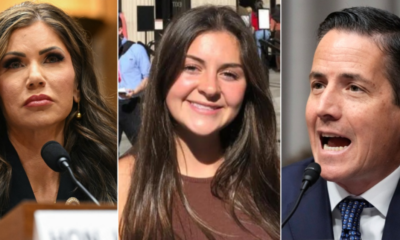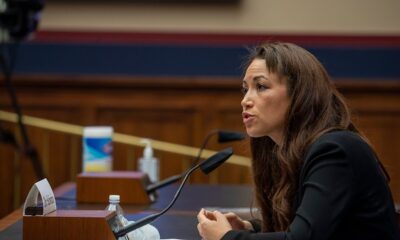Health
New report suggests ‘panic buying’ of medications by patients and providers caused drug shortages

As the “triple threat” of COVID-19, influenza and RSV (respiratory syncytial virus) caused a spike in patients seeking medication in the winter of 2022, drug shortages were the highest they had been in five years, according to a March 2023 Senate report.
In terms of what caused the shortages, a new report from the Milken Center for Public Health in Washington, D.C., suggested those shortages stemmed from individuals and providers “panic-buying” more medications than they needed amid fear and confusion.
“During COVID, we were faced with a unique situation — a pandemic that we hadn’t been faced with as a society for hundreds of years — and it did expose some fragilities,” said report co-author Sarah Wells Kocsis, director of the Milken Center for Public Health, during an interview with Fox News Digital.
‘Three-part epidemic’ triggered shortages
The convergence of COVID, flu and RSV led to a spike in demand for medications, Milken experts said.
ADDERALL AND OZEMPIC ARE IN THE SPOTLIGHT AMID WIDESPREAD DRUG SHORTAGES IN US
“As respiratory illnesses spread across the country, social media and news media fueled a frenzy around rising cases and deaths, leading many households to stockpile cold and flu medications,” stated Milken’s report, titled “Envisioning the Future of the Pharmaceutical Supply Chain to Advance Public Health in the United States.”
A new report suggests that the recent drug shortage stemmed from individuals and providers “panic-buying” more medications than they needed during a period of fear and confusion. (iStock)
“Alongside households, hospitals began stockpiling these medications, which made it difficult for pharmacies to get what they needed to meet community demands,” the report added.
This stockpiling resulted in localized “spot” shortages of Tamiflu (the most popular flu medication in the U.S.) and albuterol (an asthma treatment that opens up the airways to facilitate breathing).
“Social media and news media fueled a frenzy around rising cases and deaths.”
It also led to shortages in antibiotics such as amoxicillin and Augmentin.
“It’s commonly acknowledged that when respiratory viruses spread, antibiotics are often prescribed inappropriately … Although highly effective against bacterial infections, antibiotics are not effective against viruses,” the report explained.
Stockpiling led to ‘artificial’ shortage
While it may have appeared that the supply chain wasn’t making enough medications to handle the influx of illness, the Milken report stated that the issue was caused by consumers buying more than they actually needed, causing an “artificial” shortage.
“I think it’s very easy to immediately assume that the supply chain was broken or that people weren’t doing their part,” said Kocsis.

To prevent stockpiling that can cause shortages, the Milken report calls for greater transparency across the supply chain — particularly during times of crisis. (iStock)
Kocsis believes the shortage was prompted by an increase in demand that caught some of the manufacturers off guard, which resulted in consumers and health care providers “stockpiling temporarily.”
“These ‘spot shortages’ became a self-fulfilling prophecy, where the less [information] that was communicated about them, the more panic-buying there was,” said one unnamed expert quoted in the report.
STREP THROAT INFECTIONS HAVE SPIKED ABOVE PRE-COVID HIGHS, SAYS REPORT: ‘WE’VE MISSED CASES’
Dr. Shana Johnson, a physical medicine and rehabilitation physician in Scottsdale, Arizona, who reviewed the Milken report, is a bit skeptical about the claim that hospitals and households have stockpiled medications.
“These statements are not supported by any data or references,” she told Fox News Digital.
Communication key to preventing shortages
To prevent stockpiles that can cause shortages, the Milken report calls for greater transparency across the supply chain, particularly in times of crisis.
“When people get panicked or they’re unsure of information, that results in certain behaviors,” Kocsis told Fox News Digital.
“I think it’s very easy to immediately assume that the supply chain was broken.”
“We need to work on more comprehensive communication — not only to those who are responsible for getting the medications to the dispensing point, but also deeper into the communities we serve,” she added.
When distributors and manufacturers openly communicate the true state of supply and demand, the report said this would “better inform decisions to release public health stockpiles, help facilitate redistribution or provide alternative guidance when the recommended medications were unavailable.”
It’s also important for health care providers and pharmacists to serve as “trusted messengers” in their communities, the report added.
Use of primary care doctors over hospitals
When the “three-part epidemic” hit communities, many parents took their sick children straight to hospitals instead of to their pediatricians — which could have played a part in the drug shortage, per Milken’s report.
“This was an inefficient, expensive way to get health care,” the report said.
“Had the public health system encouraged patients to go to their primary care providers, they could have obtained clear, accurate information about appropriate levels of care and would have known how to prepare for and treat RSV, flu or COVID-19 symptoms.”

It’s important for health care providers and pharmacists to serve as “trusted messengers” in their communities, the new report said. (iStock)
For parents with young children, Kocsis stressed the importance of having a trusted relationship with their pediatricians to ensure that the appropriate medications are prescribed.
Johnson, however, questioned the statement about parents choosing hospital visits over primary doctors and noted that the statement is not supported by a reference or data.

Many parents took their sick children to hospitals instead of to their pediatricians, which could have played a part in the drug shortage, per Milken’s report. (REUTERS/Mike Blake)
“In my personal experience across two pediatrician offices in Washington and Arizona, pediatricians are particularly good at keeping kids out of the ER unless their vital signs are unstable,” she told Fox News Digital.
“They had extended hours, special weekend hours and telemedicine visits. The message was ‘call us’ and they helped.”
FIRST-EVER RSV VACCINE APPROVED BY FDA FOR ADULTS 60 AND OVER
Overall, Kocsis said there is a need to consider the appropriate use of resources throughout the health care system.
“We need to think practically about where we channel our care and make sure people know where to show up when they need that care,” she added.
The report stressed the need for health literacy education to “quell panic-buying, prevent artificial shortages and incentivize people to follow best practices when sicknesses are spreading.”
Situation is improving, expert says
Milken’s Kocsis does see a light at the end of the tunnel.
“I think the situation is improving,” she told Fox News Digital. “I think manufacturers have learned from that experience and are thinking more intentionally about anticipating increases in demand that might have caught them off guard before. They are more prepared now.”
“The pandemic highlighted weak links in public health and medical supply chain logistics.”
Johnson agreed that some opportunities have arisen from what she calls “COVID chaos.”
“The pandemic highlighted weak links in public health and medical supply chain logistics,” she told Fox News Digital.
“It’s an opportune time to use AI or other strategies to better monitor supply and demand variations, and to better anticipate need and move toward managing the supply chain as a single, integrated system,” she added.
CLICK HERE TO SIGN UP FOR OUR HEALTH NEWSLETTER
The doctor also noted that the pandemic stressed the need to provide the public with accurate, trusted information.
“For many, that source is not the government,” she said. “Health care providers without special interests or upcoming elections are better messengers.”
After completing this report, Kocsis said she feels more optimistic about the future of the pharmaceutical supply chain.
“We engaged with a diverse representation of stakeholders so we could really think about this and make sure all parties were represented, which is particularly important when you start thinking about underserved communities,” she said.
“All the leaders I spoke with are deeply committed to doing the right thing.”

Health
Jennifer Hudson Lost 80-Lbs Without Depriving Herself—Learn Her Secrets

Sign Up
Create a free account to access exclusive content, play games, solve puzzles, test your pop-culture knowledge and receive special offers.
Already have an account? Login
Use left and right arrow keys to navigate between menu items.
Use escape to exit the menu.
Health
Kennedy’s Plan for the Drug Crisis: A Network of ‘Healing Farms’

Though Mr. Kennedy’s embrace of recovery farms may be novel, the concept stretches back almost a century. In 1935, the government opened the United States Narcotic Farm in Lexington, Ky., to research and treat addiction. Over the years, residents included Chet Baker and William S. Burroughs (who portrayed the institution in his novel, “Junkie: Confessions of an Unredeemed Drug Addict”). The program had high relapse rates and was tainted by drug experiments on human subjects. By 1975, as local treatment centers began to proliferate around the country, the program closed.
In America, therapeutic communities for addiction treatment became popular in the 1960s and ’70s. Some, like Synanon, became notorious for cultlike, abusive environments. There are now perhaps 3,000 worldwide, researchers estimate, including one that Mr. Kennedy has also praised — San Patrignano, an Italian program whose centerpiece is a highly regarded bakery, staffed by residents.
“If we do go down the road of large government-funded therapeutic communities, I’d want to see some oversight to ensure they live up to modern standards,” said Dr. Sabet, who is now president of the Foundation for Drug Policy Solutions. “We should get rid of the false dichotomy, too, between these approaches and medications, since we know they can work together for some people.”
Should Mr. Kennedy be confirmed, his authority to establish healing farms would be uncertain. Building federal treatment farms in “depressed rural areas,” as he said in his documentary, presumably on public land, would hit political and legal roadblocks. Fully legalizing and taxing cannabis to pay for the farms would require congressional action.
In the concluding moments of the documentary, Mr. Kennedy invoked Carl Jung, the Swiss psychiatrist whose views on spirituality influenced Alcoholics Anonymous. Dr. Jung, he said, felt that “people who believed in God got better faster and that their recovery was more durable and enduring than people who didn’t.”
Health
Children exposed to higher fluoride levels found to have lower IQs, study reveals

The debate about the benefits and risks of fluoride is ongoing, as RFK Jr. — incoming President Trump’s pick for HHS secretary — pushes to remove it from the U.S. water supply.
“Fluoride is an industrial waste associated with arthritis, bone fractures, bone cancer, IQ loss, neurodevelopmental disorders and thyroid disease,” RFK wrote in a post on X in November.
A new study published in JAMA Pediatrics on Jan. 6 found another correlation between fluoride exposure and children’s IQs.
RFK JR. CALLS FOR REMOVAL OF FLUORIDE FROM DRINKING WATER, SPARKING DEBATE
Study co-author Kyla Taylor, PhD, who is based in North Carolina, noted that fluoridated water has been used “for decades” to reduce dental cavities and improve oral health.
Fluoride exposure has been linked to a variety of negative health effects, yet benefits oral health. (iStock)
“However, there is concern that pregnant women and children are getting fluoride from many sources, including drinking water, water-added foods and beverages, teas, toothpaste, floss and mouthwash, and that their total fluoride exposure is too high and may affect fetal, infant and child neurodevelopment,” she told Fox News Digital.
The new research, led by scientists at the National Institute of Environmental Health Sciences (NIEHS), analyzed 74 epidemiological studies on children’s IQ and fluoride exposure.
FEDERAL JUDGE ORDERS EPA FURTHER REGULATE FLUORIDE IN DRINKING WATER DUE TO CONCERNS OVER LOWERED IQ IN KIDS
The studies measured fluoride in drinking water and urine across 10 countries, including Canada, China, Denmark, India, Iran, Mexico, Pakistan, New Zealand, Spain and Taiwan. (None were conducted in the U.S.)
The meta-analysis found a “statistically significant association” between higher fluoride exposure and lower children’s IQ scores, according to Taylor.
“[It showed] that the more fluoride a child is exposed to, the more likely that child’s IQ will be lower than if they were not exposed,” she said.

Scientists found a “statistically significant association” between higher fluoride exposure and lower children’s IQ scores. (iStock)
These results were consistent with six previous meta-analyses, all of which reported the same “statistically significant inverse associations” between fluoride exposure and children’s IQs, Taylor emphasized.
The research found that for every 1mg/L increase in urinary fluoride, there was a 1.63-point decrease in IQ.
‘Safe’ exposure levels
The World Health Organization (WHO) has established 1.5mg/L as the “upper safe limit” of fluoride in drinking water.
“There is concern that pregnant women and children are getting fluoride from many sources.”
Meanwhile, the U.S. Public Health Service recommends a fluoride concentration of 0.7 mg/L in drinking water.
“There was not enough data to determine if 0.7 mg/L of fluoride exposure in drinking water affected children’s IQs,” Taylor noted.
FDA BANS RED FOOD DYE DUE TO POTENTIAL CANCER RISK
Higher levels of the chemical can be found in wells and community water serving nearly three million people in the U.S., the researcher noted.
She encouraged pregnant women and parents of small children to be mindful of their total fluoride intake.

Nearly three million people have access to wells and community water with fluoride levels above the levels suggested by the World Health Organization. (iStock)
“If their water is fluoridated, they may wish to replace tap water with low-fluoride bottled water, like purified water, and limit exposure from other sources, such as dental products or black tea,” she said.
“Parents can use low-fluoride bottled water to mix with powdered infant formula and limit use of fluoridated toothpaste by young children.”
For more Health articles, visit www.foxnews.com/health.
While the research did not intend to address broader public health implications of water fluoridation in the U.S., Taylor suggested that the findings could help inform future research into the impact of fluoride on children’s health.
Dental health expert shares cautions
In response to this study and other previous research, Dr. Ellie Phillips, DDS, an oral health educator based in Austin, Texas, told Fox News Digital that she does not support water fluoridation.

The study researcher encouraged parents of small children to be mindful of their total fluoride intake. (iStock)
“I join those who vehemently oppose public water fluoridation, and I question why our water supplies are still fluoridated in the 21st century,” she wrote in an email.
“There are non-fluoridated cities and countries where the public enjoy high levels of oral health, which in some cases appear better than those that are fluoridated.”
CLICK HERE TO SIGN UP FOR OUR HEALTH NEWSLETTER
Phillips called the fluoride debate “confusing” even among dentists, as the American Dental Association (ADA) advocates for fluoride use for cavity prevention through water fluoridation, toothpaste and mouthwash — “sometimes in high concentrations.”

Fluoride is used in water, toothpaste and mouthwash to help prevent cavities. (iStock)
“[But] biologic (holistic) dentists generally encourage their patients to fear fluoride and avoid its use entirely, even if their teeth are ravaged by tooth decay,” she said.
“Topical fluoride is beneficial, while systemic consumption poses risks.”
Phillips encouraged the public to consider varying fluoride compounds, the effect of different concentrations and the “extreme difference” between applying fluoride topically and ingesting it.
“Topical fluoride is beneficial, while systemic consumption poses risks,” she cautioned.
“Individuals must take charge of their own oral health using natural and informed strategies.”
The study received funding from the National Institute of Environmental Health Sciences (NIEHS), the National Institutes of Health (NIH) and the Intramural Research Program.
-
/cdn.vox-cdn.com/uploads/chorus_asset/file/25822586/STK169_ZUCKERBERG_MAGA_STKS491_CVIRGINIA_A.jpg)
/cdn.vox-cdn.com/uploads/chorus_asset/file/25822586/STK169_ZUCKERBERG_MAGA_STKS491_CVIRGINIA_A.jpg) Technology1 week ago
Technology1 week agoMeta is highlighting a splintering global approach to online speech
-

 Science1 week ago
Science1 week agoMetro will offer free rides in L.A. through Sunday due to fires
-
/cdn.vox-cdn.com/uploads/chorus_asset/file/23935558/acastro_STK103__01.jpg)
/cdn.vox-cdn.com/uploads/chorus_asset/file/23935558/acastro_STK103__01.jpg) Technology7 days ago
Technology7 days agoAmazon Prime will shut down its clothing try-on program
-

 News1 week ago
News1 week agoMapping the Damage From the Palisades Fire
-
/cdn.vox-cdn.com/uploads/chorus_asset/file/25826211/lorealcellbioprint.jpg)
/cdn.vox-cdn.com/uploads/chorus_asset/file/25826211/lorealcellbioprint.jpg) Technology7 days ago
Technology7 days agoL’Oréal’s new skincare gadget told me I should try retinol
-
/cdn.vox-cdn.com/uploads/chorus_asset/file/25832751/2192581677.jpg)
/cdn.vox-cdn.com/uploads/chorus_asset/file/25832751/2192581677.jpg) Technology3 days ago
Technology3 days agoSuper Bowl LIX will stream for free on Tubi
-

 Business5 days ago
Business5 days agoWhy TikTok Users Are Downloading ‘Red Note,’ the Chinese App
-
/cdn.vox-cdn.com/uploads/chorus_asset/file/25835602/Switch_DonkeyKongCountryReturnsHD_scrn_19.png)
/cdn.vox-cdn.com/uploads/chorus_asset/file/25835602/Switch_DonkeyKongCountryReturnsHD_scrn_19.png) Technology1 day ago
Technology1 day agoNintendo omits original Donkey Kong Country Returns team from the remaster’s credits



















